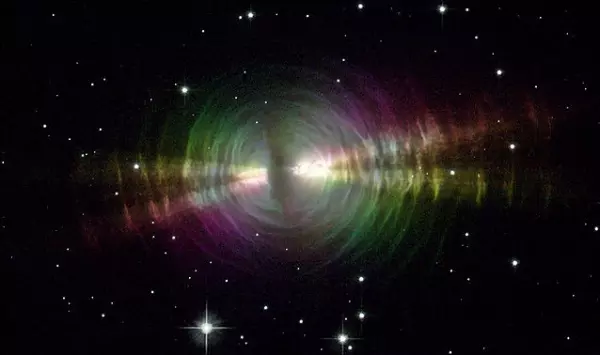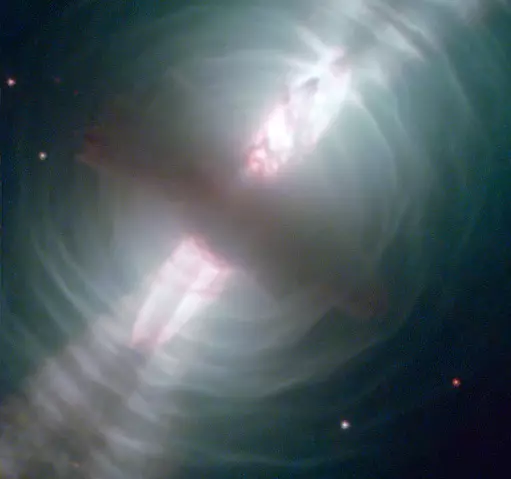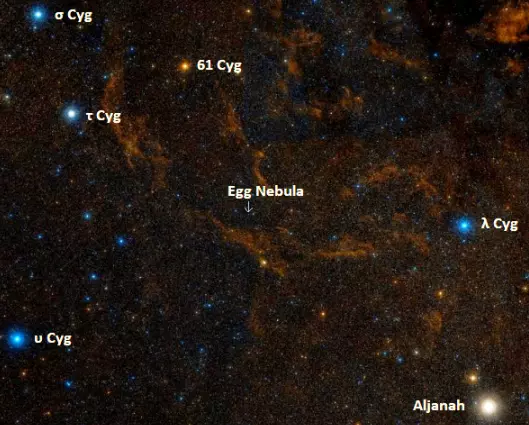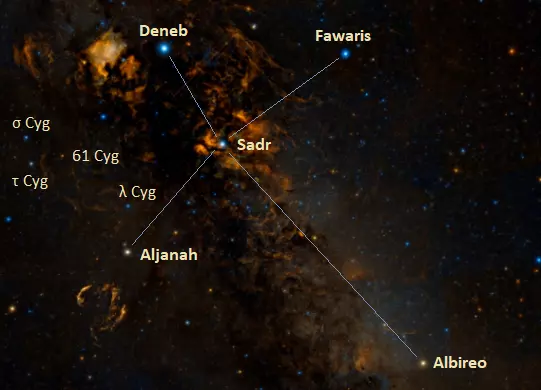The Egg Nebula is a protoplanetary nebula located in the northern constellation Cygnus. It lies at an approximate distance of 3,000 light years and has an apparent magnitude of 14.0. Named for its peculiar shape, the bipolar nebula was created when a supergiant star in a late stage of its life cycle ejected shells of dust and gas into space. The star will soon start ionizing the nebula, transforming it into a planetary nebula.
The central star of the Egg Nebula, catalogued as V1610 Cygni, is blocked from view by thick clouds of dust. Its light escapes along the polar axis and is reflected by the thinner shells of material further out. The dust shell surrounding the star is believed to be an accretion disk. The beams of light are caused by light from the star escaping through holes in the obscuring thick shell. The bright rings intersecting the beams are shells of expelled material, expanding at 20 km/s. The material is ejected in bursts that occur every few hundred years.
C1610 Cygni has the stellar classification F5Iae, indicating a yellow supergiant. The General Catalogue of Variable Stars lists a magnitude of 5.800 for the star at maximum brightness.

Resembling a rippling pool illuminated by underwater lights, the Egg Nebula offers astronomers a special look at the normally invisible dust shells swaddling an aging star. These dust layers, extending over one-tenth of a light-year from the star, have an onionskin structure that forms concentric rings around the star. A thicker dust belt, running almost vertically through the image, blocks off light from the central star. Twin beams of light radiate from the hidden star and illuminate the pitch-black dust, like a shining flashlight in a smoky room. The Egg Nebula is located 3, 000 light-years away in the constellation Cygnus. This image was taken with Hubble’s Advanced Camera for Surveys in September and October 2002. Image: NASA/ESA and The Hubble Heritage Team STScI/AURA)
The Egg Nebula has an angular size of 0.562 by 0.389 arcminutes. With an apparent magnitude of 14, it can only be observed in larger telescopes. In a 10-inch instrument, it appears as a bright but small patch of nebulosity. The bipolar structure is visible at higher magnifications.
Protoplanetary nebulae are relatively short-lived stages of a star’s evolution before the star expels its outer layers and becomes hot enough to ionize them. These nebulae last only a few thousand years and are quite rare. Only about a hundred protoplanetary nebulae are known today. In comparison, about 1,500 planetary nebulae have been discovered; they last about 10,000 years.
The stars that produce protoplanetary nebulae are in the late phases of the asymptotic giant branch (AGB). These are evolved, cool, highly luminous stars with a mass between 0.6 and 10 times that of the Sun. They lose a lot of mass through a strong stellar wind and are usually long-period variables, stars whose brightness varies due to pulsations. During the protoplanetary nebula phase, the stars are still too cool to ionize the shells of expelled material, but their effective temperature keeps rising. Once it reaches around 30,000 K, the stars become hot enough to ionize the surrounding nebulae, which then become planetary nebulae.
In the AGB phase, the stars fuse helium in a shell around a carbon-oxygen core and expand to enormous proportions. Once they exhaust the supply of helium, their main source of energy becomes hydrogen fusion in a thin shell that prevents the inner helium shell from fusing stably. Over time, the helium builds up and ignites the helium shell. The event is known as the helium shell flash. It increases the star’s luminosity by thousands of times for a brief period and causes the star to cool and swell in size. As a result, the hydrogen shell burning is shut off until the helium shell burning comes close to the hydrogen shell and reignites it, starting the cycle again. As the star’s luminosity increases, so does the instability of its envelope, ultimately resulting in the ejection of a planetary nebula. The thermal pulses last only a few hundred years.

At the centre of this image, and hidden in a thick cloud of dust, is the nebula’s central star. While we can’t see the star directly, four searchlight beams of light coming from it shine out through the nebula. It is thought that ring-shaped holes in the thick cocoon of dust, carved by jets coming from the star, let the beams of light emerge through the otherwise opaque cloud. The precise mechanism by which stellar jets produce these holes is not known for certain, but one possible explanation is that a binary star system, rather than a single star, exists at the centre of the nebula. Image: ESA/Hubble & NASA
Facts
The Egg Nebula was the first protoplanetary nebula discovered. It was first detected as a bright far-infrared source associated with an axisymmetric nebula in the 1970s. Prior to this, it was listed as a pair of galaxies by the Swiss astronomer Fritz Zwicky (ZW IV 67) in his catalogue of compact galaxies. It was also listed as UGC 11668 in the Uppsala General Catalogue of Galaxies (Nilson, 1973).
The central star of the Egg Nebula was assigned the spectral type F5 Ia in 1975 based on spectroscopic observations of the spectra of its starlight.
In 2000, astronomers reported the detection of a prominent source of direct unpolarized emission in addition to the central illuminator within the nebula. The source is believed to be a wide binary companion to V1610 Cygni.
The Egg Nebula is one of the several egg nebulae in the sky. It is not to be confused with the Fried Egg Nebula (Hen 3-1379), a planetary nebula in Scorpius, nor with the protoplanetary Robin’s Egg Nebula (NGC 1360) in Fornax and the Rotten Egg Nebula (Calabash Nebula, OH 231.84 +4.22) near the open cluster Messier 46 in Puppis.
Location
The Egg Nebula lies in the region of the Northern Cross in Cygnus. It can be found roughly halfway between Aljanah (Epsilon Cygni) at the Swan’s wing and Sigma Cygni, just east of Lambda Cygni.

Egg Nebula location, image: Wikisky

Aljanah location, image: Wikisky
The best time of year to observe the Egg Nebula and other deep sky objects in Cygnus is during the month of September, when the constellation is high overhead in the evening sky.
Egg Nebula – RAFGL 2688
| Constellation | Cygnus |
| Right ascension | 21h 02m 18.75s |
| Declination | +36° 41′ 37.8″ |
| Apparent magnitude | 14.0 |
| Absolute magnitude | 4.2 |
| Distance | 3,000 light years (920 parsecs) |
| Apparent size | 30″ × 15″ |
| Radius | 0.2 light years |
| Names and designations | Egg Nebula, Cygnus Egg, RAFGL 2688, IRAS R21003+3629, GSC 02713-01972, PK 080-06 1, PN G080.1-06.5, UGC 11668, V1610 Cyg, AAVSO 2058+36 |